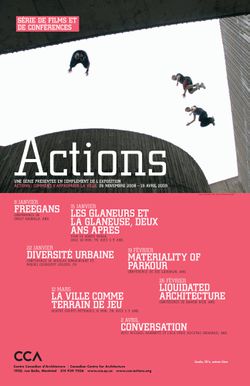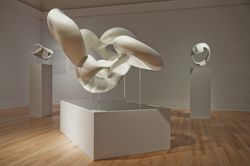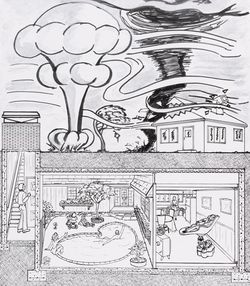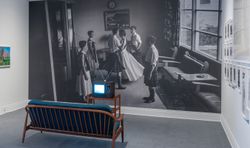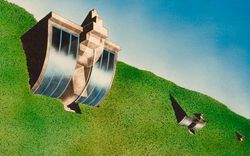drawings
AP148.S1.1970.PR02.001.6
Description:
Appear to be storyboard drawings, with each square advancing a narrative about the planet earth.
ca. 1970-1971
Sketches, Interplanetary Architecture (Folder 6 of 7)
Actions:
AP148.S1.1970.PR02.001.6
Description:
Appear to be storyboard drawings, with each square advancing a narrative about the planet earth.
drawings
ca. 1970-1971
Project
AP207.S1.2013.PR01
Description:
The project series documents "The Game of Architecture", a drawing realized in 2013. The drawing is of triangular-shaped structures made of bricks standing in a desert. This drawing is a reinterpretation of a previous project by Pettena "Situazioni Competitive" in 1971. "Here architecture, albeit with the same characteristic of competitiveness, becomes indistinct, confused, no longer the leading actor, at the mercy of an unknown context (a desert? the nature of an alien planet?) which, threatening to overwhelm it, seems to nullify its every need and characteristic." [1] The project series contains a drawing for the 2013 edition and the 2018 version, which is a digital photograph modified to show the architectural construction standing in rough water. Source: [1] Gianni Pettena website, https://www.giannipettena.it/italiano/opere-1/nat-the-game-of-architecture-2013-1/ (last accessed 28 January 2020)
2011-2018
The Game of Architecture (2013)
Actions:
AP207.S1.2013.PR01
Description:
The project series documents "The Game of Architecture", a drawing realized in 2013. The drawing is of triangular-shaped structures made of bricks standing in a desert. This drawing is a reinterpretation of a previous project by Pettena "Situazioni Competitive" in 1971. "Here architecture, albeit with the same characteristic of competitiveness, becomes indistinct, confused, no longer the leading actor, at the mercy of an unknown context (a desert? the nature of an alien planet?) which, threatening to overwhelm it, seems to nullify its every need and characteristic." [1] The project series contains a drawing for the 2013 edition and the 2018 version, which is a digital photograph modified to show the architectural construction standing in rough water. Source: [1] Gianni Pettena website, https://www.giannipettena.it/italiano/opere-1/nat-the-game-of-architecture-2013-1/ (last accessed 28 January 2020)
Project
2011-2018
Project
AP148.S1.1970.PR02
Description:
The project series documents Poli's work on the Interplanetary Architecture project, which was also made into a film by Superstudio directed by Alessandro Poli (the film is not included in the fonds). The project reflects Poli's deep fascination with the moon landing in 1969. Poli uses this major media event as a catalyst for thinking about a new approach to architecture and tools for design, including the idea that film and the movie camera should become part of the toolset. The project also seems to be in some way a response to Epoch magazine's challenge for a "Primo concorso di architettura nello spazio" (the first architectural competition in space), and includes much imagery and textual references to a new road or architectural links between the earth and other planets, including an earth moon highway. In his storyboard, Poli also makes reference to his earlier Piper project, and some imagery features wheels and an amusement park. The Interplanetary Architecture project was exhibited by Superstudio in Rome in 1972 and featured in "Casabella" magazine in April 1972 (no. 364). The project was also featured in the 2010 CCA exhibition "Other Space Odysseys". In the accompanying CCA publication, Poli describes this project as "a voyage off earthbound routes in quest of architecture unfettered by the urban nightmare, by induced needs or by planning as the only tool for regulating and solving the world's problems" (Poli quoted in Borasi and Zardini, 2010, 110). Poli's work on this project is deeply tied to the Zeno project, which was also featured in this exhibition and is included in this fonds (see AP148.S1.1972.PR01). For the Zeno project, Poli envisioned a dialogue between astronaut Buzz Aldrin and an Italian peasant, Zeno of Riparbella. Poli felt that these two shared a similarity in that both their homes were isolated capsules, one that provided a lens from which to see the rest of the world and understand their place in it. The material in the series includes numerous photomontages and collages of astronauts in space, as well as drawings of plantery shapes and structures. There are also texts, some of which include calculations of distances and diameters of planets, as well as notebooks and sketchbooks, many of which Poli included in a folder he entitled "Storyboard." The series also includes an unsent letter from Poli to Adolfo Natalini which describes how, after the moon landing, everything - the planet, the moon, the stars - is architecture, and that this will necessitate the need for new design tools, such as the movie camera. Some works are signed Alessandro Poli-Superstudio. Source cited: Giovanna Borasi and Mirko Zardini, eds., Other Space Odysseys, Montreal and Baden: Canadian Centre for Architecture/Lars Müller Publishers, 2010.
1969-1971
Architettura Interplanetaria [Interplanetary Architecture] (1970-1971)
Actions:
AP148.S1.1970.PR02
Description:
The project series documents Poli's work on the Interplanetary Architecture project, which was also made into a film by Superstudio directed by Alessandro Poli (the film is not included in the fonds). The project reflects Poli's deep fascination with the moon landing in 1969. Poli uses this major media event as a catalyst for thinking about a new approach to architecture and tools for design, including the idea that film and the movie camera should become part of the toolset. The project also seems to be in some way a response to Epoch magazine's challenge for a "Primo concorso di architettura nello spazio" (the first architectural competition in space), and includes much imagery and textual references to a new road or architectural links between the earth and other planets, including an earth moon highway. In his storyboard, Poli also makes reference to his earlier Piper project, and some imagery features wheels and an amusement park. The Interplanetary Architecture project was exhibited by Superstudio in Rome in 1972 and featured in "Casabella" magazine in April 1972 (no. 364). The project was also featured in the 2010 CCA exhibition "Other Space Odysseys". In the accompanying CCA publication, Poli describes this project as "a voyage off earthbound routes in quest of architecture unfettered by the urban nightmare, by induced needs or by planning as the only tool for regulating and solving the world's problems" (Poli quoted in Borasi and Zardini, 2010, 110). Poli's work on this project is deeply tied to the Zeno project, which was also featured in this exhibition and is included in this fonds (see AP148.S1.1972.PR01). For the Zeno project, Poli envisioned a dialogue between astronaut Buzz Aldrin and an Italian peasant, Zeno of Riparbella. Poli felt that these two shared a similarity in that both their homes were isolated capsules, one that provided a lens from which to see the rest of the world and understand their place in it. The material in the series includes numerous photomontages and collages of astronauts in space, as well as drawings of plantery shapes and structures. There are also texts, some of which include calculations of distances and diameters of planets, as well as notebooks and sketchbooks, many of which Poli included in a folder he entitled "Storyboard." The series also includes an unsent letter from Poli to Adolfo Natalini which describes how, after the moon landing, everything - the planet, the moon, the stars - is architecture, and that this will necessitate the need for new design tools, such as the movie camera. Some works are signed Alessandro Poli-Superstudio. Source cited: Giovanna Borasi and Mirko Zardini, eds., Other Space Odysseys, Montreal and Baden: Canadian Centre for Architecture/Lars Müller Publishers, 2010.
Project
1969-1971
Urban Diversity
Two members of the French collective Coloco, architect Nicolas Bonnenfant and landscape architect Miguel Georgieff, present their project “Habiter les Squelettes,” which aims to recover and renovate unfinished, abandoned structures or “urban skeletons”, giving rise to a new dimension in self-building: lifespan management, including that of everyday objects such as(...)
Paul Desmarais Theatre
22 January 2009
Urban Diversity
Actions:
Description:
Two members of the French collective Coloco, architect Nicolas Bonnenfant and landscape architect Miguel Georgieff, present their project “Habiter les Squelettes,” which aims to recover and renovate unfinished, abandoned structures or “urban skeletons”, giving rise to a new dimension in self-building: lifespan management, including that of everyday objects such as(...)
Paul Desmarais Theatre
Other Space Odysseys presents three approaches to the idea of an adventurous journey that started forty years ago after the 1969 moon landing. Featuring the work of architects Greg Lynn, Michael Maltzan, and Alessandro Poli, Other Space Odysseys comes at a time when space exploration is the subject of renewed enthusiasm, but also of debate which questions its(...)
Main galleries
8 April 2010 to 19 September 2010
Other Space Odysseys: Greg Lynn, Michael Maltzan, Alessandro Poli
Actions:
Description:
Other Space Odysseys presents three approaches to the idea of an adventurous journey that started forty years ago after the 1969 moon landing. Featuring the work of architects Greg Lynn, Michael Maltzan, and Alessandro Poli, Other Space Odysseys comes at a time when space exploration is the subject of renewed enthusiasm, but also of debate which questions its(...)
Main galleries
drawings
AP148.S1.1970.PR02.006
Description:
Drawings of planets and other structures. Possibly a copy of other storyboard drawings by Poli.
ca. 1970-1971
Planetary drawings, Interplanetary Architecture
Actions:
AP148.S1.1970.PR02.006
Description:
Drawings of planets and other structures. Possibly a copy of other storyboard drawings by Poli.
drawings
ca. 1970-1971
Join 2023 CCA-WRI Fellows Andrea Alberto Dutto, Oxana Gourinovitch, and Tomomi Miyata as they share their research on how the underground has evolved as a space of Cold War anxiety and resource extraction, to contemporary concerns around climate and other unnational disasters from which the earth can provide shelter.
Online Keyword(s):
Andrea Alberto Dutto, Oxana Gourinovitch, Tomomi Miyata, Yoshiharu Tsukamoto, Jungyoon Kim, WRI, light, planet
10 August 2023, 9 a.m. to noon
Underground Anxieties: 2023 CCA-WRI Research Symposium
Actions:
Description:
Join 2023 CCA-WRI Fellows Andrea Alberto Dutto, Oxana Gourinovitch, and Tomomi Miyata as they share their research on how the underground has evolved as a space of Cold War anxiety and resource extraction, to contemporary concerns around climate and other unnational disasters from which the earth can provide shelter.
Online Keyword(s):
Andrea Alberto Dutto, Oxana Gourinovitch, Tomomi Miyata, Yoshiharu Tsukamoto, Jungyoon Kim, WRI, light, planet
research
CCA-WRI Research Fellowship Program 2022
Casper Laing Ebbensgaard, Alina Nazmeeva, Jessica Vaughn, Yoshiharu Tsukamoto, Gökçe Günel, WRI, light, planet
1 July 2022 to 30 September 2022
research
1 July 2022 to
30 September 2022
Casper Laing Ebbensgaard, Alina Nazmeeva, Jessica Vaughn, Yoshiharu Tsukamoto, Gökçe Günel, WRI, light, planet
In an age of unprecedented human impact on the planet, certain countries stand out for their privileged positions and the complexity of their relationships with the land. Stories about Canada closely follow the discovery and appropriation of vast and varied natural resources as well as changing ideas of the proper relationship between people and their environment.(...)
16 November 2016 to 9 April 2017
It’s All Happening So Fast
Actions:
Description:
In an age of unprecedented human impact on the planet, certain countries stand out for their privileged positions and the complexity of their relationships with the land. Stories about Canada closely follow the discovery and appropriation of vast and varied natural resources as well as changing ideas of the proper relationship between people and their environment.(...)
articles
Using the Earth for Shelter
The planet is the client
